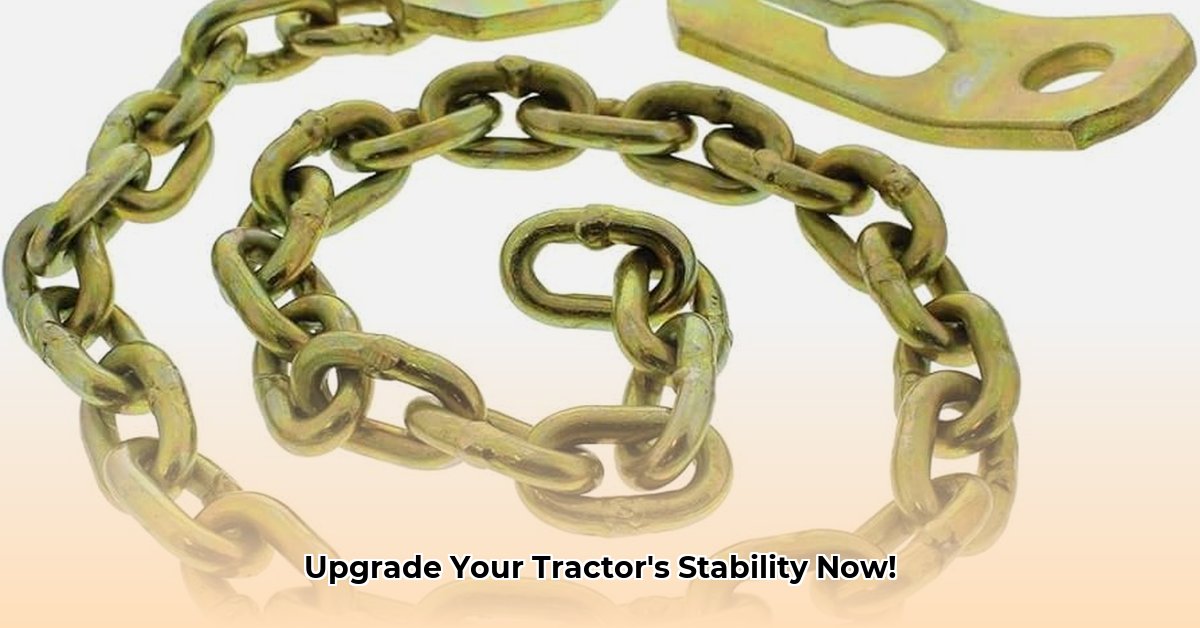
Understanding Tractor Stabilizer Chains
Tractor stabilizer chains are essential safety features for tractors, especially those operating on uneven terrain or pulling heavy implements. They significantly enhance stability by counteracting sway and reducing the risk of tipping, protecting both the equipment and the operator. This guide focuses on tractors in the 15-40 horsepower range, a common size for hobby farms and smaller agricultural operations. These chains work by connecting the tractor's three-point hitch to the lower links, creating a counterbalance that resists sideways movement. Adjustable turnbuckles allow for precise tension adjustment, crucial for optimizing stability in varying conditions. For more information on 3-point hitch attachments, see this helpful resource: 3-point hitch info.
Choosing the Right Stabilizer Chains
Selecting the appropriate stabilizer chains is crucial. Unfortunately, a lack of standardization in the market requires careful consideration of several factors. Your tractor’s owner's manual is the primary source of compatibility information. If unsure, consult your local dealer.
Key Selection Criteria:
- Chain Thickness: Measured in inches, a thicker chain implies greater strength and durability. Thicker chains are better suited for heavier loads and more demanding conditions.
- Material: High-carbon steel or galvanized steel offers superior rust resistance and longevity compared to standard steel. Always check for resistance to corrosion.
- Turnbuckle Strength: The turnbuckle's weight capacity (in pounds) dictates its ability to withstand tension. A higher capacity ensures reliable performance and safety.
- Brand Reputation: Opt for established brands with a history of quality and positive customer feedback. Look for established brands with positive reviews showing reliability.
Comparative Table (Example): (Note: Prices and availability are subject to change. This table serves as an example only. Always verify specifications with the manufacturer.)
| Brand | Chain Thickness (inches) | Material | Turnbuckle Strength (lbs) | Approximate Price ($) | Compatibility Notes |
|---|---|---|---|---|---|
| Brand A | 3/8 | High-Carbon Steel | 5000 | 75-100 | Check manual for fit |
| Brand B | 1/2 | Galvanized Steel | 7500 | 90-120 | Universal fit, but verify |
| Brand C | 7/16 | High-Tensile Steel | 6000 | 85-110 | Check specific models |
Installation and Maintenance: A Step-by-Step Guide
Correct installation and regular maintenance are paramount for optimal performance and safety. Always ensure your tractor is parked on level ground with the engine off before beginning any work.
Installation:
- Preparation: Clear the work area and ensure the tractor is safely parked.
- Attachment: Securely attach one end of each chain to the lower links of the three-point hitch.
- Connection: Connect the other ends to designated points on your tractor's frame or lift arms (consult your owner's manual).
- Tension Adjustment: Utilize the turnbuckles to achieve appropriate tension. Avoid over-tightening, which can damage equipment. A slight slack is usually acceptable.
- Verification: Test the chains in a safe area before operating the tractor to confirm smooth movement and proper tension.
Maintenance:
- Before each use, visually inspect chains for wear, damage, or rust.
- Periodically lubricate chains and turnbuckles to reduce friction and extend lifespan.
- Replace worn or damaged components immediately. Don't underestimate the importance of preventative maintenance.
Safety Considerations
- Always operate your tractor with undamaged chains.
- Wear appropriate safety gear, including sturdy footwear and gloves, during installation and operation.
- Never exceed the rated weight capacity of your chains.
- Proper tension is crucial – too tight can cause damage, too loose reduces effectiveness. Consult your manual for how much slack is optimal.
Sustainability Considerations
Choose chains made from recycled materials whenever possible to minimize environmental impact. When your chains reach the end of their life, dispose of them responsibly according to local regulations; many recycling centers accept scrap metal.
Conclusion: Prioritize Safety and Efficiency
Investing in high-quality tractor stabilizer chains is vital for the safety and longevity of your equipment. By following this guide, you can ensure your tractor operates safely and efficiently for years to come. Remember, proactive maintenance is key to preventing costly repairs and accidents. Choosing the correct chains, coupled with diligent maintenance, will reduce the risk of tractor instability.